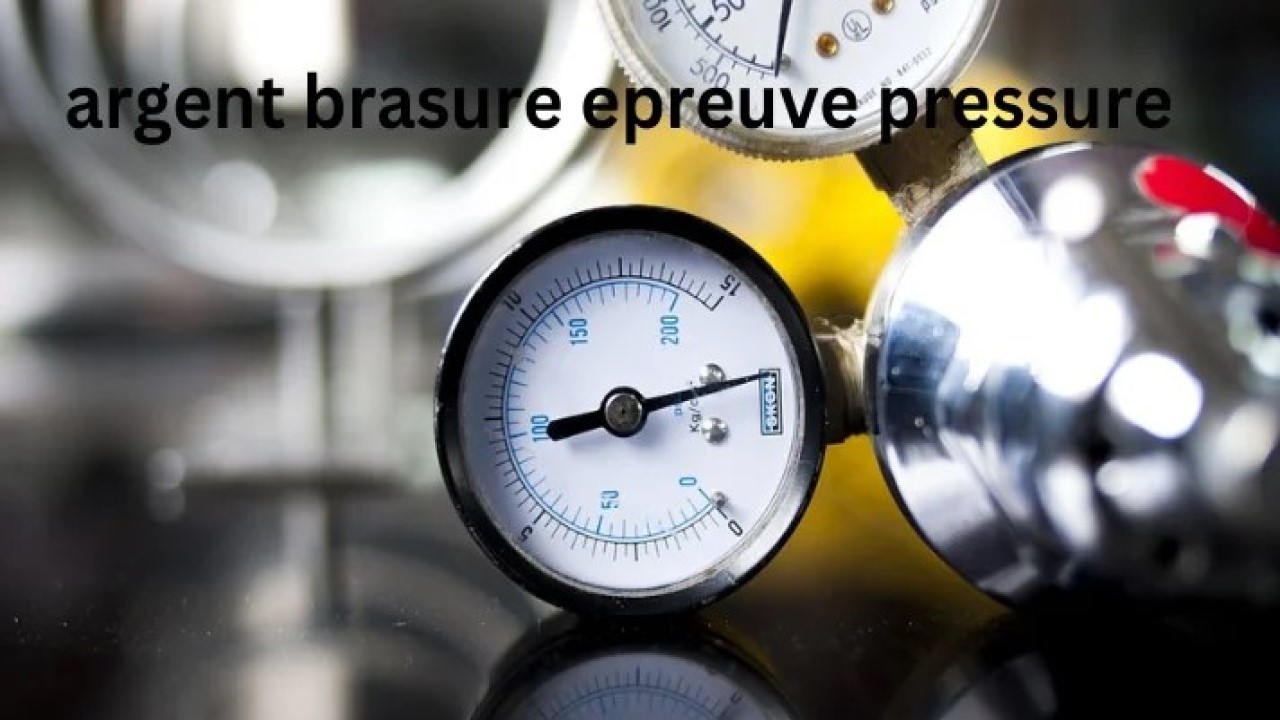Argent brasure epreuve pressure, often referred to simply as epreuve pressure, is a critical aspect of metallurgy and engineering, particularly in industries where high-pressure systems are involved. This term originates from French, where “argent brasure” translates to “silver brazing” and “epreuve” means “test” or “proof.” In essence, it signifies the pressure testing of silver-brazed joints. In this article, we will delve into the concept of argent Brasure pressure, its significance, methodology, applications, and importance in ensuring the integrity and safety of various mechanical structures.
What is Argent Brasure Epreuve Pressure?
Argent brasure pressure is a technique employed to test the strength and integrity of joints created through silver brazing. Silver brazing, also known as silver soldering, is a joining process wherein a filler metal, typically an alloy containing silver, is melted and flowed into the joint between two workpieces, forming a strong bond upon solidification. Epreuve pressure involves subjecting these brazed joints to elevated pressure levels to verify their resistance to leakage, deformation, or failure under operating conditions.
Significance of Argent Brasure Epreuve Pressure:
- Safety Assurance:
- One of the primary reasons for conducting argent pressure pressure tests is to ensure the safety and reliability of mechanical systems. Components such as pipes, fittings, and pressure vessels must withstand the pressures they are subjected to during normal operation without compromising safety.
- Quality Control:
- Epreuve pressure testing serves as a crucial quality control measure during the manufacturing process of various industrial components. By subjecting brazed joints to pressure, manufacturers can identify any defects, such as incomplete fusion or inadequate penetration, that could compromise the integrity of the assembly.
- Compliance with Standards:
- Many industries, including aerospace, automotive, and plumbing, have stringent regulations and standards governing the design and fabrication of pressure-containing equipment. Argent brasure pressure testing helps ensure compliance with these standards, thereby mitigating the risk of accidents and regulatory non-compliance.
Methodology of Argent Brasure Epreuve Pressure Testing:
- Preparation:
- Before conducting epreuve pressure testing, the brazed joint must be thoroughly cleaned to remove any contaminants that could affect the test results. Additionally, the test setup, including pressure gauges, valves, and safety devices, should be inspected and calibrated to ensure accuracy.
- Pressurization:
- The test specimen, typically a section of piping or a pressure vessel containing the brazed joint, is gradually pressurized using a hydraulic pump or compressed gas source. The pressure is increased incrementally while monitoring for any signs of leakage or deformation.
- Holding Period:
- Once the desired pressure level is reached, the specimen is held at that pressure for a specified duration, allowing sufficient time to assess its stability and integrity. During this period, inspectors may visually inspect the joint for any indications of failure, such as leaks or bulging.
- Depressurization and Examination:
- After the holding period, the pressure is gradually released, and the test specimen is carefully examined for any signs of damage or failure. This examination may involve non-destructive testing techniques such as dye penetrant inspection or ultrasound to detect internal defects that may not be visible to the naked eye.
Applications of Argent Brasure Epreuve Pressure Testing:
- Aerospace Industry:
- In the aerospace sector, argent brasure epreuve pressure testing is used to validate the integrity of critical components such as hydraulic lines, fuel systems, and engine components, ensuring they can withstand the extreme conditions encountered during flight.
- Automotive Manufacturing:
- Automotive manufacturers employ epreuve pressure testing to assess the reliability of cooling systems, air conditioning lines, and brake assemblies, guaranteeing the safety and performance of vehicles on the road.
- Plumbing and HVAC:
- In the construction industry, Epreuve pressure testing is commonly used to verify the integrity of plumbing systems and HVAC (heating, ventilation, and air conditioning) ductwork, preventing costly leaks and ensuring occupant comfort and safety.
Importance of Argent Brasure Epreuve Pressure Testing:
Argent brasure Epreuve pressure testing plays a vital role in ensuring the safety, reliability, and regulatory compliance of pressure-containing systems across various industries. By subjecting brazed joints to elevated pressures, manufacturers can identify and rectify any defects before components are put into service, thereby minimizing the risk of catastrophic failures and ensuring the longevity of mechanical structures.
Conclusion:
Argent brasure epreuve pressure testing is a fundamental process in the realm of metallurgy and engineering, particularly in industries where the integrity of pressure-containing systems is paramount. By subjecting brazed joints to elevated pressures and assessing their response, manufacturers can validate the quality of their products, comply with regulatory standards, and ensure the safety of end-users. As technology advances and safety regulations become more stringent, the importance of pressure testing in maintaining the integrity of mechanical structures will continue to grow, driving innovation and excellence in manufacturing practices.
FAQs Related to Argent Brasure Epreuve Pressure:
What is argent brasure epreuve pressure?
Argent brasure epreuve pressure refers to the testing method used to evaluate the strength and integrity of joints created through silver brazing. It involves subjecting these brazed joints to elevated pressure levels to ensure they can withstand the operational pressures they will encounter.
Why is argent brasure epreuve pressure testing important?
Epreuve pressure testing is crucial for ensuring the safety, reliability, and regulatory compliance of pressure-containing systems in various industries. By subjecting brazed joints to pressure, manufacturers can identify any defects or weaknesses that could compromise the integrity of the components.
What industries commonly use argent brasure epreuve pressure testing?
Industries such as aerospace, automotive manufacturing, plumbing, and HVAC (heating, ventilation, and air conditioning) commonly utilize epreuve pressure testing to validate the integrity of critical components and systems.
What are the key steps involved in argent brasure pressure testing?
The key steps in epreuve pressure testing include preparation of the test specimen, pressurization using hydraulic pumps or compressed gas sources, holding the specimen at the desired pressure, and examining it for any signs of leakage or deformation after depressurization.
How does Argent brasure epreuve pressure testing ensure compliance with regulatory standards?
Epreuve pressure testing helps manufacturers ensure compliance with stringent regulatory standards governing the design and fabrication of pressure-containing equipment. By conducting these tests, manufacturers can demonstrate the safety and reliability of their products to regulatory authorities.
What are some common applications of argent brasure pressure testing?
Argent brasure Epreuve pressure testing is commonly used in applications such as testing hydraulic lines and fuel systems in aerospace components, assessing the reliability of cooling systems and brake assemblies in automotive manufacturing, and verifying the integrity of plumbing and HVAC ductwork in the construction industry.
Can argent brasure pressure testing detect internal defects in brazed joints?
Yes, Epreuve pressure testing can detect internal defects in brazed joints by subjecting them to elevated pressures and examining them using non-destructive testing techniques such as dye penetrant inspection or ultrasound.
How often should argent brasure pressure testing be conducted?
The frequency of epreuve pressure testing depends on various factors, including industry regulations, operating conditions, and the criticality of the components being tested. In general, it is conducted during the manufacturing process and periodically during the service life of the equipment to ensure ongoing safety and reliability.







